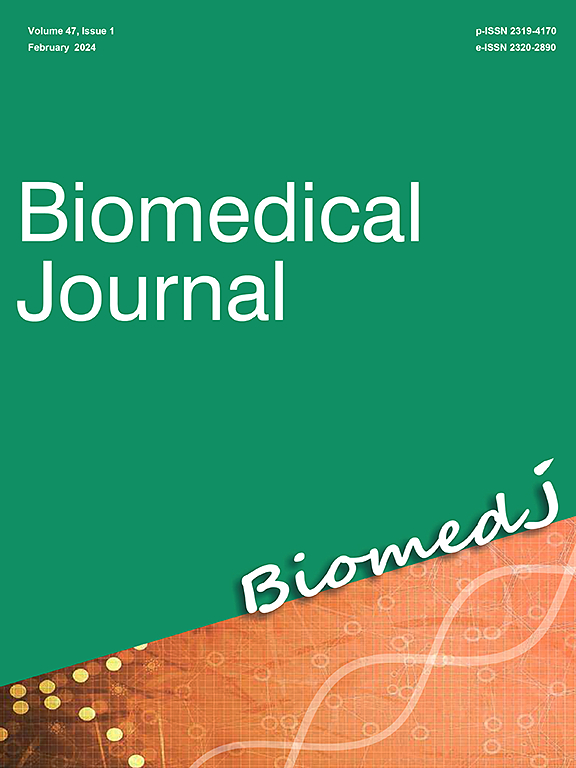经胸超声心动图对急性 A 型主动脉综合征的诊断准确性:系统回顾与元分析》。
IF 4.1
3区 医学
Q2 BIOCHEMISTRY & MOLECULAR BIOLOGY
引用次数: 0
摘要
背景:经胸超声心动图(TTE)目前被认为是疑似急性 A 型主动脉综合征(AAAS)患者的潜在一线成像检查。如果两个主动脉管腔之间有内膜瓣分隔,或在升主动脉看到主动脉壁增厚,则检测 AAAS 的直接 TTE 征象为阳性。间接 TTE 征象显示 AAAS 的高风险特征,如主动脉根部扩张、心包积液和主动脉瓣反流。我们的目的是总结有关 TTE 诊断准确性的现有临床证据,并评估其在疑似 AAAS 患者管理中的潜在作用:我们从 PubMed、EMBASE、MEDLINE 和 Cochrane 图书馆等数据库中纳入了以任何语言撰写的前瞻性或回顾性诊断队列研究,这些研究特别关注使用 TTE 诊断 AAAS。我们计算了 TTE 诊断 AAAS 的集合敏感性、特异性、阳性似然比 (PLR)、阴性似然比 (NLR)、诊断几率比 [1] 和分层汇总接收者操作特征曲线 (HSROC)。我们应用了诊断准确性质量评估(QUADAS-2)工具和推荐、评估、发展和评价分级(GRADE)质量评估标准:10项研究(2886名患者)被纳入荟萃分析。直接 TTE 征兆的汇总灵敏度和特异性分别为 58%(95% CI,38-76%)和 94%(95% CI,89-97%)。对于任何 TTE 征象,汇总的敏感性和特异性分别为 91%(95% CI,85-94%)和 74%(95% CI,61-84%)。四项研究的 HSROC 曲线下面积[0.95 (95% CI, 0.92-0.96) vs. 0.87 (95% CI, 0.84-0.90)]显示,直接 TTE 征象的诊断准确性明显高于任何 TTE 征象:我们的研究表明,TTE 可作为疑似 AAAS 患者的初始影像学检查。鉴于其特异性较高,出现直接的 TTE 征象可能预示着 AAAS 的存在,而没有任何 TTE 征象,再加上临床怀疑度较低,则表明 AAAS 的可能性较低。本文章由计算机程序翻译,如有差异,请以英文原文为准。
Diagnostic accuracy of transthoracic echocardiography for acute type A aortic syndrome: A systematic review and meta-analysis
Background
Transthoracic echocardiography (TTE) is currently recognized as the potential first-line imaging test for patients with suspected acute type A aortic syndrome (AAAS). Direct TTE sign for detecting AAAS is positive if there is an intimal flap separating two aortic lumens or aortic wall thickening seen in the ascending aorta. Indirect TTE sign indicates high-risk features of AAAS, such as aortic root dilatation, pericardial effusion, and aortic regurgitation. Our aim is to summarize the existing clinical evidence regarding the diagnostic accuracy of TTE and to evaluate its potential role in the management of patients with suspected AAAS.
Methods
We included prospective or retrospective diagnostic cohort studies, written in any language, that specifically focused on using TTE to diagnose AAAS from databases such as PubMed, EMBASE, MEDLINE, and the Cochrane Library. The pooled sensitivity, specificity, positive likelihood ratio (PLR), negative likelihood ratio (NLR), diagnostic odds ratio (DOR) , and hierarchical summary receiver-operating characteristic (HSROC) curve were calculated for TTE in diagnosing AAAS. We applied Quality Assessment of Diagnostic Accuracy (QUADAS-2) tool and Grading of Recommendations, Assessment, Development and Evaluation (GRADE) quality assessment criteria.
Results
Ten studies (2886 patients) were included in the meta-analysis. The pooled sensitivity and specificity of direct TTE signs were 58% (95% CI, 38–76%) and 94% (95% CI, 89–97%). For any TTE signs, the pooled sensitivity and specificity were 91% (95% CI, 85–94%) and 74% (95% CI, 61–84%). The diagnostic accuracy of direct TTE signs was significantly higher than that of any TTE signs, as measured by the area under the HSROC curve [0.95 (95% CI, 0.92–0.96) vs. 0.87 (95% CI, 0.84–0.90)] in four studies.
Conclusions
Our study suggests that TTE could serve as the initial imaging test for patients with suspected AAAS. Given its high specificity, the presence of direct TTE signs may indicate AAAS, whereas the absence of any TTE signs, combined with low clinical suspicion, could suggest a lower likelihood of AAAS.
求助全文
通过发布文献求助,成功后即可免费获取论文全文。
去求助
来源期刊

Biomedical Journal
Medicine-General Medicine
CiteScore
11.60
自引率
1.80%
发文量
128
审稿时长
42 days
期刊介绍:
Biomedical Journal publishes 6 peer-reviewed issues per year in all fields of clinical and biomedical sciences for an internationally diverse authorship. Unlike most open access journals, which are free to readers but not authors, Biomedical Journal does not charge for subscription, submission, processing or publication of manuscripts, nor for color reproduction of photographs.
Clinical studies, accounts of clinical trials, biomarker studies, and characterization of human pathogens are within the scope of the journal, as well as basic studies in model species such as Escherichia coli, Caenorhabditis elegans, Drosophila melanogaster, and Mus musculus revealing the function of molecules, cells, and tissues relevant for human health. However, articles on other species can be published if they contribute to our understanding of basic mechanisms of biology.
A highly-cited international editorial board assures timely publication of manuscripts. Reviews on recent progress in biomedical sciences are commissioned by the editors.
 求助内容:
求助内容: 应助结果提醒方式:
应助结果提醒方式:


